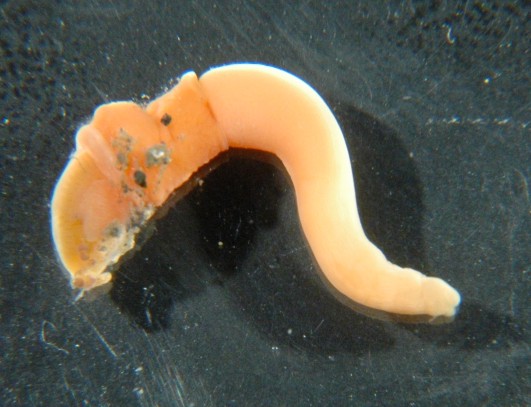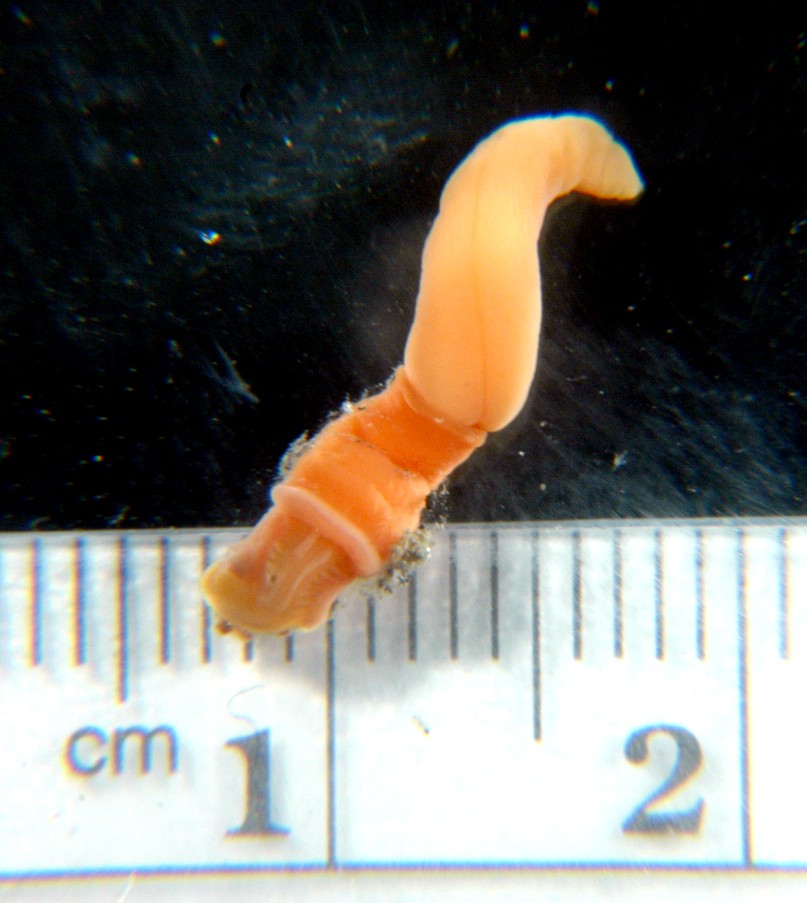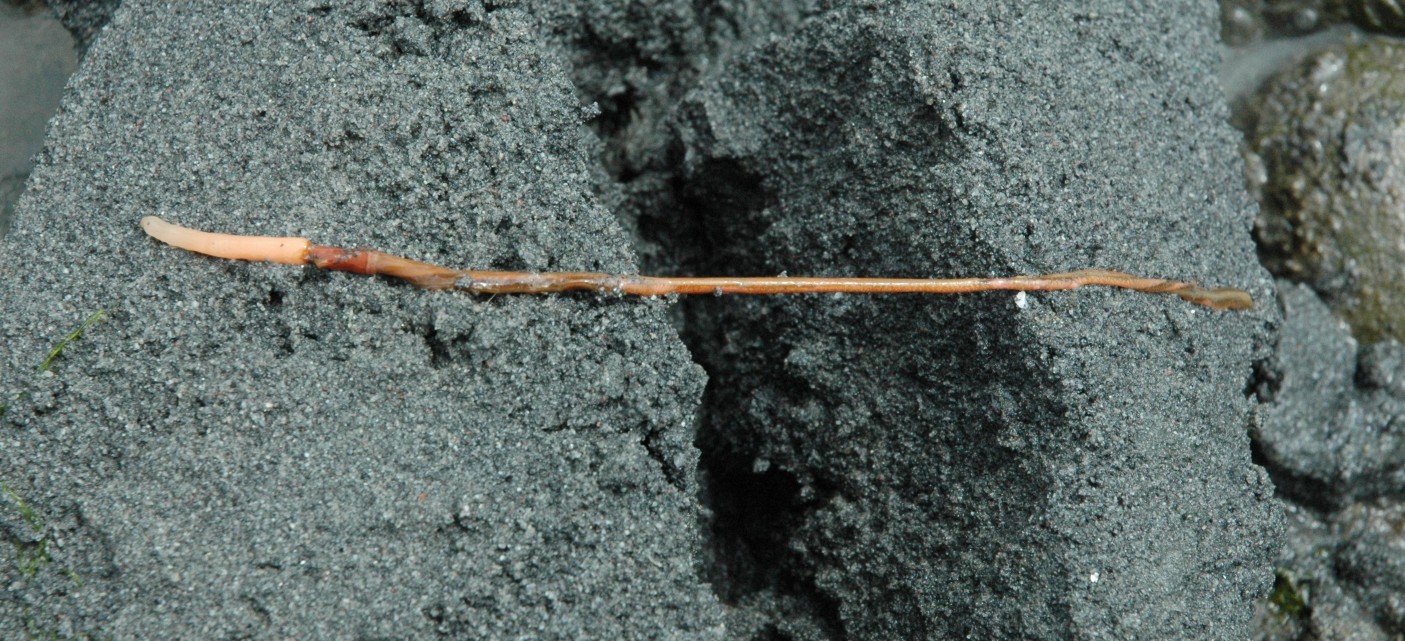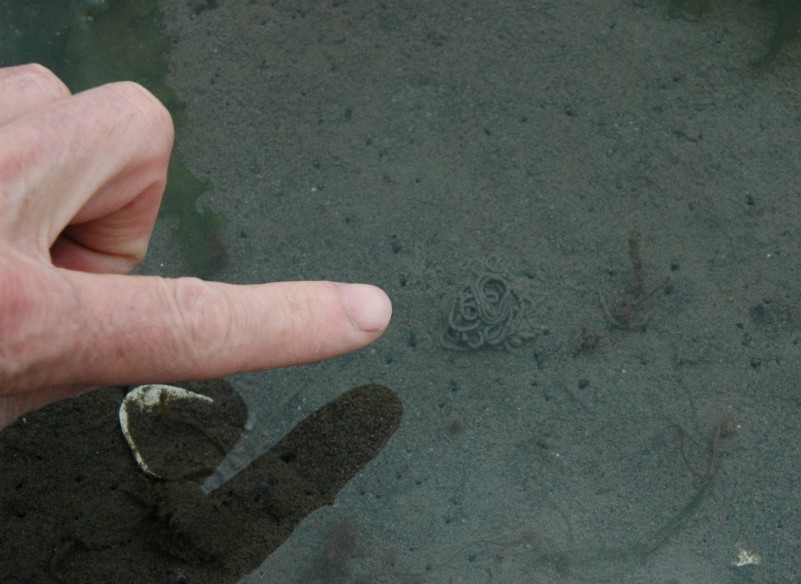Saccoglossus bromophenolosus King 1994Common name(s): Acorn worm |
|
| Synonyms: |  |
|
Class Enteropneusta
(acorn worms)
Family Harrimaniidae
|
|
| Saccoglossus bromophemolosus from Padilla Bay. The proboscis is to the right, the collar is in the middle, and the trunk is to the left. The trunk is strongly contracted and may be cut off. Total length of this individual" 16 mm | |
| (Photo by: Dave Cowles, June 2009) | |
Much of the information on this page is derived from Smith et al., 2003.
How to Distinguish from Similar Species: Saccoglossus pusillus, which is found from California to the N tip of Vancouver Island, is found in more exposed areas and occurs in sand or under rocks. It has a bright orange proboscis, collar, and trunk. The dorsal groove in the proboscis is pronounced. Total length is up to 60 mm. Adults have 26-53 pairs of gill bars.
Geographical Range: Maine to Nova Scotia in the Atlantic, and Padilla Bay and Willapa Bay in Washington.
Depth Range: Most Enteropneusts are intertidal, though a few species range down to 100 m depth.
Habitat: In the mud in muddy bays.
Biology/Natural History: 18s mtDNA sequences show that the Padilla Bay and Willapa Bay populations are virtually genetically identical to one another, implying that they were transplanted to Padilla Bay from Willapa Bay relatively recently (they were reported in Willapa Bay in 1910 (after oysters were introduced there from the east coast) and described there by Woodwick, 1951). The WA specimens were identical to the Maine specimens in their 18s mtDNA but differed from the Maine specimens by a 3 base pair difference in the 16s mtDNA sequence. The mouth is on the ventral side at the junction of the proboscis and collar, usually hidden in the groove which separates the proboscis/collar. The gills are in the anterior part of the trunk, which has gill pores in this section. The pores may be elevated, or may be sunken into a longitudinal depression. The trunk also has a middorsal and a midventral ridge. Sexes are separate but difficult to distinguish. Eggs are large (up to 1 mm) and yolky in Family Harrimaniidae, which also has direct development--no swimming (tornaria) larva. S. pusillus near San Diego was found to stick the eggs to the side of the burrow (or these may be a remnant left behind after spawning).
An isolated Enteropneust proboscis and collar lives and moves for some time but does not apear to regenerate. Pieces of the trunk can regenerate into an entire individual.
This species seems to avoid bright light, an observation also noted in Hyman, 1959.Enteropneusts are so similar to one another that no Orders have been set up within the Class (Human, 1959)
Enteropneusts burrow by using the proboscis. This is elongated and thrust forward, then contracted longitudinally to form a bulge. This bulge is moved posteriorly to the base of the proboscis, pulling the animal forward. The collar and trunk move forward passively. Cilia on the surface of the proboscis and collar also move sand posteriorly.
| Return to: | |||
| Main Page | Alphabetic Index | Systematic Index | Glossary |
References:
Dichotomous Keys:Carlton, 2007
General References:
Scientific Articles:
Hyman, Libby H., 1959. The Invertebrates: Smaller Coelomic Groups. pp. 72-155. McGraw-Hill Book Co., New York. 783 pp.
King, G.M., C. Giray, and I. Kornfield, 1994. A new hemichordate, Saccoglossus bromphenolosus (Hemichordata: Enteropneusta: Harrimaniidae) from North America. Proceedings of the Biological Society of Washington 107: pp 383-390
Smith, Shannon E., Rob Douglas, Karen Burke da Silva, and Billie J. Swalla, 2003. Morphological and molecular identification of Saccoglossus species (Hemichordata: Harrimaniidae) in the Pacific Northwest. Canadian Journal of Zoology 81: pp 133-141
Woodwick, K.H., 1951. The morphology of Saccoglossus sp. of Willapa Bay. Master's thesis, University of Washington, Seattle.
Web sites:
General Notes and Observations: Locations, abundances, unusual behaviors:

In this view the animal has writhed around into a position in which the dorsal groove in the proboscis can be seen. Some of the gill bars in the trunk can also be seen.

This larger individual is about 100 mm long. Shown on the muddy sand it was living in. Proboscis is to the left, then the collar, and long trunk to the right.

The worms produce this fine fecal casting.
Authors and Editors of Page:
Dave Cowles (2009): Created original page
CSS coding for page developed by Jonathan Cowles (2007)